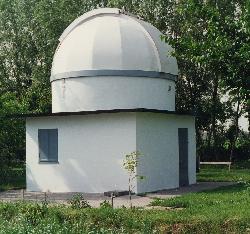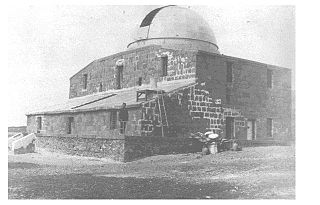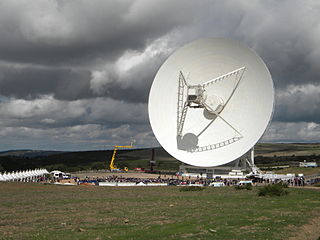
Bassano Bresciano is a comune in the province of Brescia, in Lombardy. As of 2011 Bassano Bresciano had a population of 2,237.

Antonio Abetti was an Italian astronomer.

Prof Giorgio Abetti HFRSE was an Italian solar astronomer.

Arcetri is a location in Florence, Italy, positioned among the hills south of the city centre.

The Telescopio InfraRosso del Gornergrat (TIRGO), or the Gornergrat Infrared Telescope, was located on the northern tower of the Kulm Hotel at Gornergrat near Zermatt, Switzerland. It was a 1.5-metre (4.9 ft) Cassegrain telescope with a tip-tilt correcting secondary and optimized for infrared observations, but was decommissioned in March 2005. The telescope and related instrumentation were run by the Istituto di Radioastronomia, sezione di Firenze, with the assistance of the Osservatorio Astrofisico di Arcetri and the Dipartimento di Astronomia e Scienza dello Spazio of the University of Florence.

The Asiago Astrophysical Observatory is an Italian astronomical observatory owned and operated by the University of Padua. Founded in 1942, it is located on the plateau of Asiago, 90 kilometers northwest of Padua, near the town of Asiago. Its main instrument is the 1.22-meter Galilei telescope, currently used only for spectrometric observations.

The Monte Mario Observatory is an astronomical observatory and is administratively part of the Observatory of Rome. It is located atop Monte Mario, near the right bank of the river Tiber, in the municipality of Rome, Italy. This location was used as the prime meridian for maps of Italy until the 1960s.

The Astronomical Observatory of Capodimonte is the Neapolitan department of Istituto Nazionale di Astrofisica, the most important Italian institution promoting, developing and conducting scientific research in the fields of astronomy, astrophysics, and space science.

The Catania Observatory is an astronomical observatory in the city of Catania, on the island of Sicily in southern Italy. It is operated by INAF, the National Institute for Astrophysics.

The Brera Observatory is an astronomical observatory in the Brera district of Milan, Italy. It was built in the historic Palazzo Brera in 1764 by the Jesuit astronomer Roger Boscovich. Following the suppression of the Jesuits by Clement XIV on 21 July 1773, the palace and the observatory passed to the then rulers of northern Italy, the Austrian Habsburg dynasty.

Astronomical Observatory of Trieste is an astronomical center of studies located in the city of Trieste in northern Italy.

The Astronomical Observatory of Rome is one of twelve Astronomical Observatories in Italy. The main site of the Observatory is Monte Porzio Catone. Part of the Istituto Nazionale di Astrofisica since 2002.

The Pistoia Mountains Astronomical Observatory, also known as the San Marcello Observatory and the Pian dei Termini Observatory, is an astronomical observatory in San Marcello Piteglio, Tuscany, central Italy.

The National Institute for Astrophysics is an Italian research institute in astronomy and astrophysics, founded in 1999. INAF funds and operates twenty separate research facilities, which in turn employ scientists, engineers and technical staff. The research they perform covers most areas of astronomy, ranging from planetary science to cosmology.

The Sardinia Radio Telescope (SRT) is 64-metre fully steerable radio telescope near San Basilio, Province of Cagliari, Sardinia, Italy. Completed in 2011, it is a collaboration between the Istituto di Radioastronomia di Bologna, the Cagliari Observatory (Cagliari) and the Arcetri Astrophysical Observatory (Florence).

Villa il Gioiello is a villa in Florence, central Italy, famous for being one of the residences of Galileo Galilei, which he lived in from 1631 until his death in 1642. It is also known as Villa Galileo.

PLAnetary Transits and Oscillations of stars (PLATO) is a space telescope under development by the European Space Agency for launch in 2026. The mission goals are to search for planetary transits across up to one million stars, and to discover and characterize rocky extrasolar planets around yellow dwarf stars, subgiant stars, and red dwarf stars. The emphasis of the mission is on Earth-like planets in the habitable zone around Sun-like stars where water can exist in a liquid state. It is the third medium-class mission in ESA's Cosmic Vision programme and is named after the influential Greek philosopher Plato. A secondary objective of the mission is to study stellar oscillations or seismic activity in stars to measure stellar masses and evolution and enable the precise characterization of the planet host star, including its age.

Franco Pacini was an Italian astrophysicist and professor at the University of Florence. He carried out research, mostly in High Energy Astrophysics, in Italy, France, United States and at the European Southern Observatory.

The Giuseppe S. Vaiana Astronomical Observatory is an astronomical observatory located in Palermo, Sicily, Italy, housed inside the Palazzo dei Normanni. It is one of the research facilities of the National Institute of Astrophysics. The observatory carries out research projects in the field of astronomy and astrophysics including the study of solar and stellar coronas, stellar evolution and of the supernova remnants.

Attilio Colacevich was an Italian astronomer.




















